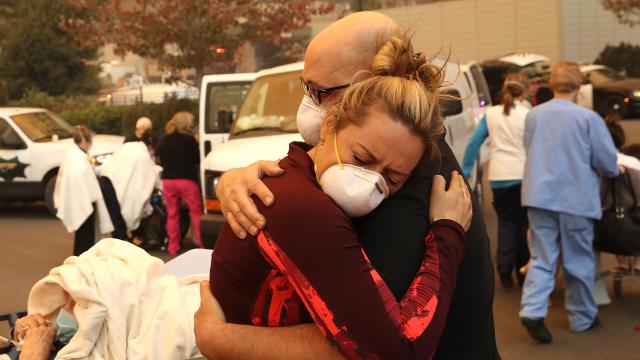A surgical mask isn’t going to protect your lungs from bush fire smoke, so if you’re in a smoky area, make sure you have the right mask and you know how to wear it before its too late.
Which Masks Actually Work?
You want a mask that will filter out small particles. Look for ones labelled P95, N95, or R95, which filter out 95 per cent of small particles when worn properly. If you find higher numbers, like P100, N100, or R100, those are even better.
The letter (P, N, or R) describes whether the mask is oil resistant, which shouldn’t be an issue if you’re using it to protect against bush fire smoke. You can read more about mask ratings here.
You can find masks at pharmacies, hardware stores, and painting supply stores.
The following masks will not protect very well from bush fire smoke:
-
Surgical masks (the kind that look like a square of cloth with loops for the ears) are designed to filter the air that you’re breathing out. They don’t have a good enough seal to protect you from particles in the air you’re breathing in.
-
Dust masks don’t protect against small enough particles. These are usually paper masks with one strap, and may also be labelled as “comfort” or “nuisance” masks.
If you don’t have a proper mask, a dust mask is probably better than nothing since there may be large particles in the air as well. But get yourself a proper mask if you can.
These masks don’t last forever, so stock up if you can. You should discard a mask when it gets clogged with dust, if it’s torn, or if it’s been damaged in such a way that it no longer fits properly.
How to Wear Your Mask
If you already have breathing issues, like asthma or COPD, ask a health professional whether you’re better off with or without the mask. Breathing through a mask does make things harder for your lungs.
Start by checking that your mask has two straps, not just one. (If you bought the right kind of mask, it will.) Both straps go around the back of your head, one above the level of your ears and one below. The mask itself fits over your nose, and under your chin.
Next, make sure you have a good seal. If there’s a gap between your skin and the mask, smoky air can whoosh in when you breathe, defeating the whole purpose. Adjust the mask to get a good seal all around the edges. If you have a beard, or even stubble, you may have a hard time getting a proper fit. They don’t make these masks in children’s sizes, either.
Masks Aren’t Perfect Protection
One pitfall of masks is that people stay out in the smoke longer when they think they’re protected. Continue following other precautions; it’s a mask, not a magical force field.
Masks only protect against particles in the air. Smoke can also carry irritating gases, and the masks don’t filter those out.
Stay indoors when the air quality is bad, and keeping your indoor air clean by keeping doors and windows closed, running your air conditioner with the fresh-air intake closed, and considering a HEPA filter to remove particles from the air. Also keep an ear out for evacuation orders in your area should the fire move in your direction.
Don’t smoke, don’t burn candles, and try not to vacuum because that stirs up dust.

Comments